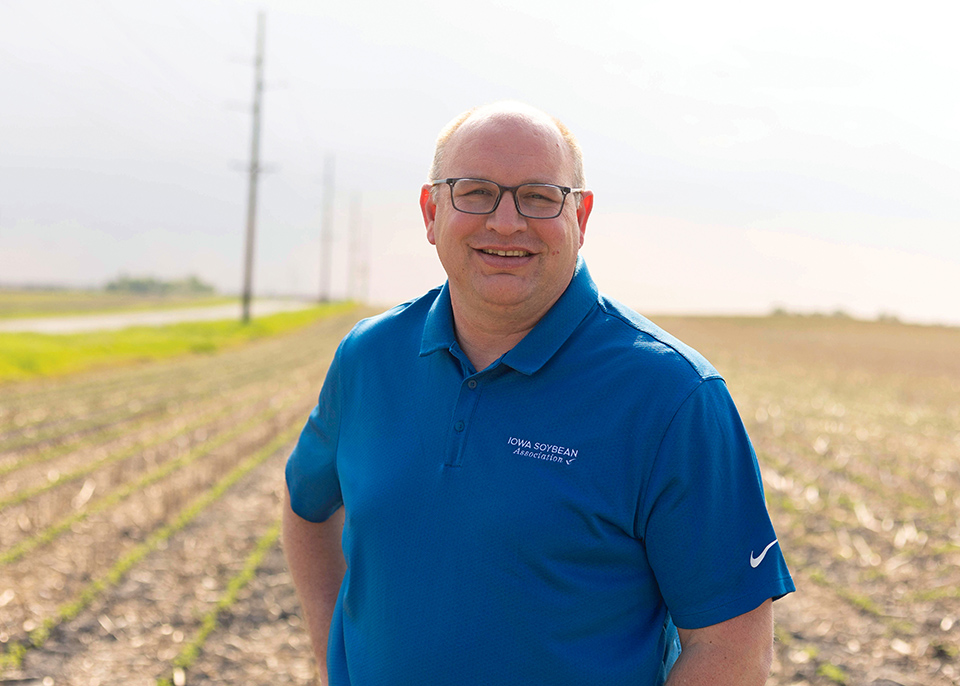
(Photo: Iowa Soybean Association / Joclyn Bushman)
Manure research projects continue
February 5, 2024
When it comes to manure application, finding the right balance is key to protecting the environment and one’s bottom line.
The Iowa Soybean Association (ISA) is researching ways to improve manure management to increase profitability while reducing nutrient losses through two different research projects. This research is funded with non-checkoff dollars from industry, state and federal partners.
Manure is an important source of nutrients for crop production, but manured production is sometimes associated with excessive nutrient losses. This nutrient loss is because manure is very heterogeneous, and it can be difficult for a farmer to gauge how much nitrogen or phosphorus is being applied with each manure source.
Applying the right amount
One of the projects uses near-infrared-reflectance (NIR) sensor technology as manure is being applied to target the nutrients you want applied rather than focusing on how many gallons per acre, says ISA Director of Research Joe McClure.
Manure Sense is a newer technology from John Deere that uses their Harvest Labs NIR sensor to estimate the amount of nutrients being applied vs. gallons or pounds of manure applied.
During application, the amount of manure applied is adjusted based on NIR sensor readings of nitrogen or phosphorus compared to flat rate applications of manure. As manure is a very heterogenous source of nutrients, researchers have found that this technology has immense potential to reduce the under- and over-application of manure.
ISA is partnering with ag biosystems engineers at Iowa State University (ISU) to validate and improve the calibration of NIR sensors for manure management.
“This fluctuates the flow up and down the field,” McClure says, noting manure’s consistency is ever changing. “It’s a way to spread this valuable resource out to more acres and prevent overapplication.”
McClure says there’s also the chance for underapplying, hurting a farmer’s return on investment because they might miss out of fully-realized yields.
This three-year project is going into year two, he says, and is focused 100% on corn crops.
McClure says they hope to have the complete data from the NIR project by late 2025 to see if the technology is allowing farmers to apply the right amount. The JD Manure Sense product is available today, McClure notes, but there are other brands that are available today or could be coming to the market in the next few years.
Early NIR indications from year one, he notes, show that lab results matched “very, very closely” to what the sensor said in the field.
“We’re really excited about the concept,” McClure says.
Working in tandem
Another ISA project seeks to understand the use of cover crops in manured production.
This project, scheduled to wrap up by the end of 2026, suggests that cover crops, like cereal rye, may help to keep the manure from moving away from the field.
“Cover crops can grab and lock up those nutrients. We believe it can be a really valuable tool,” McClure says.
Cover crops, which McClure hypothesizes the study will show, can work in tandem with manure to prove a yield advantage for corn crops. Early results indicate, but not conclusively, positive results.
At a location with a large corn yield increase, soil temperatures remained warm well into the early winter, creating conditions where manure nitrogen was converted to nitrate. The cover crop sequestered the nitrate lost to production and made it available during the growing season into the following spring.
Not an either-or proposition
“Both of these projects are important as we look at helping our farmers being more profitable,” McClure says.
A more targeted approach to manure management could also prevent phosphorus and nitrogen from leaving Iowa’s fields.
“We are focused on the profits and the benefits to the environment,” McClure says, adding that those ideas are not mutually exclusive. “We don’t want producers to throw away those dollars on the field.”
More participation sought
While ISU is conducting the bulk of the foundational research, McClure says ISA is the next layer of research as the project scales from research farms to on-farm trials.
These research projects, however, need more buy-in from farmers, and McClure says finding producers to be a part of the research is important.
“We’re trying to find enough people to visualize the value,” he says.
McClure says ISA wants to conduct on-farm trials in every region of the state, so each test area is relatively close to every farmer in Iowa.
While the focus of these research projects is on corn production currently, research efforts are expected to expand in the coming seasons to see how precise manure management and application might enhance soybean production.
McClure invites farmers to participate in this trial and others planned for 2024. He says discussions about this project and more will be part of this month’s Innovation to Profit Series in Storm Lake, Fairfield, Lewis and Waterloo.
“We want to get more people involved.”
Back